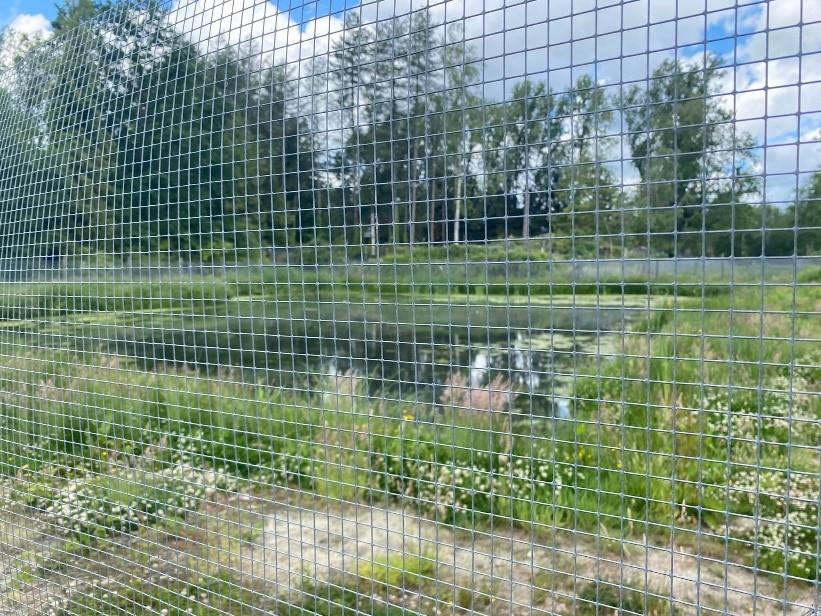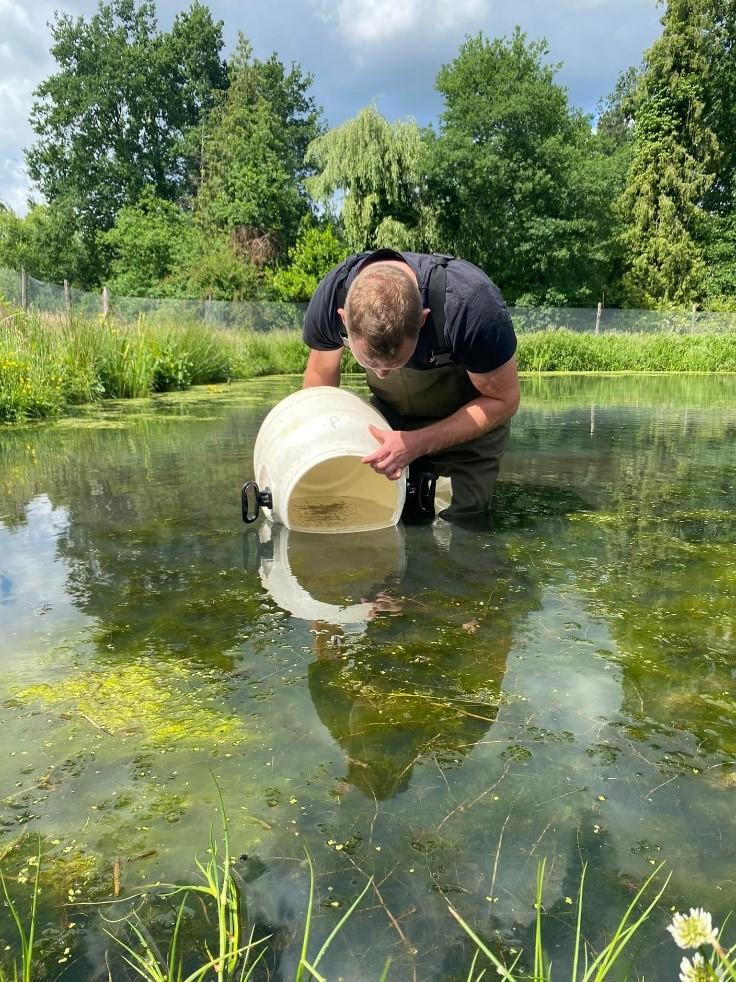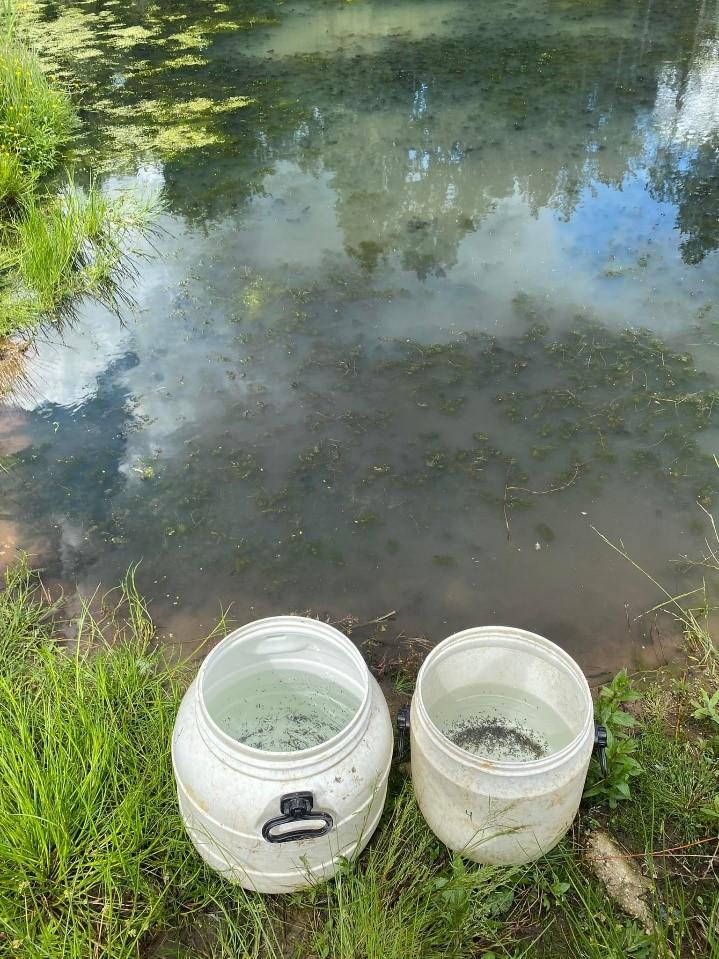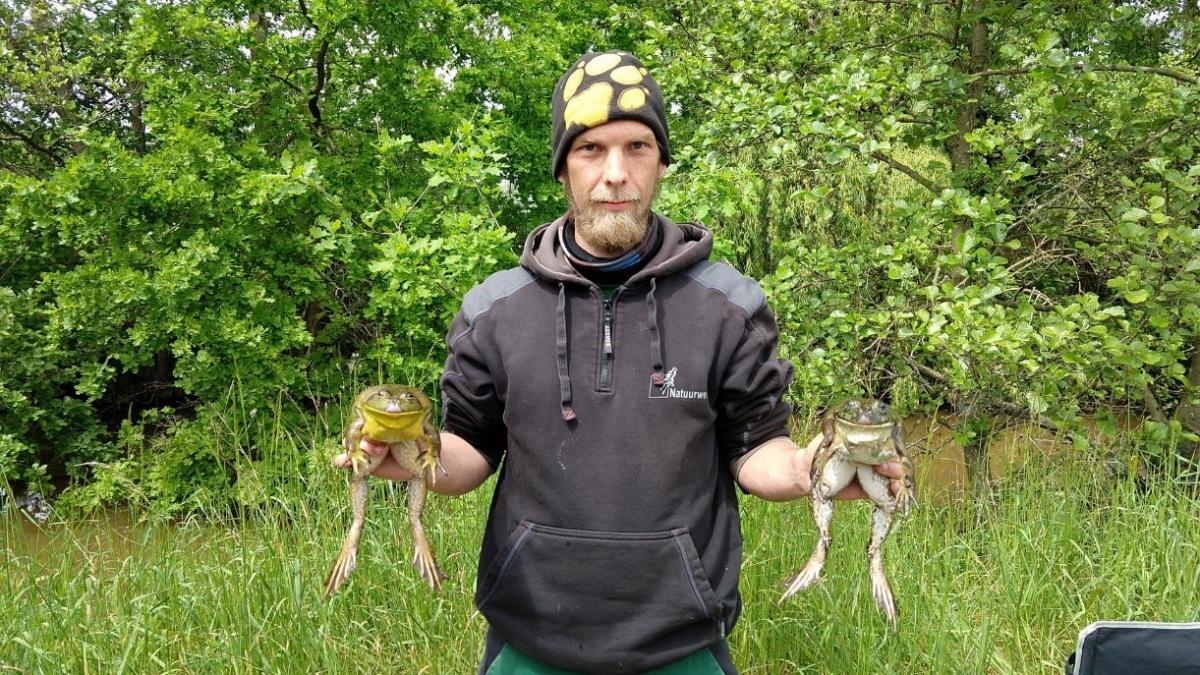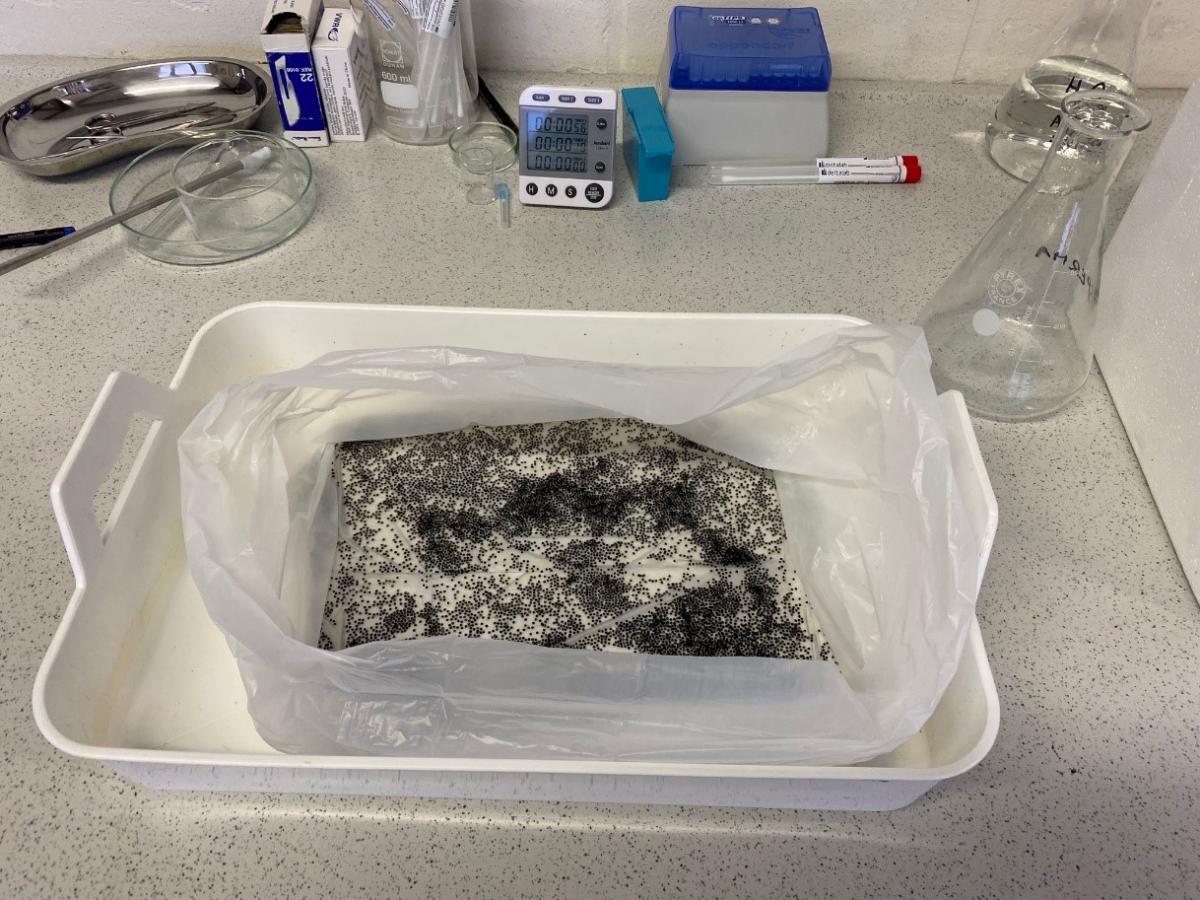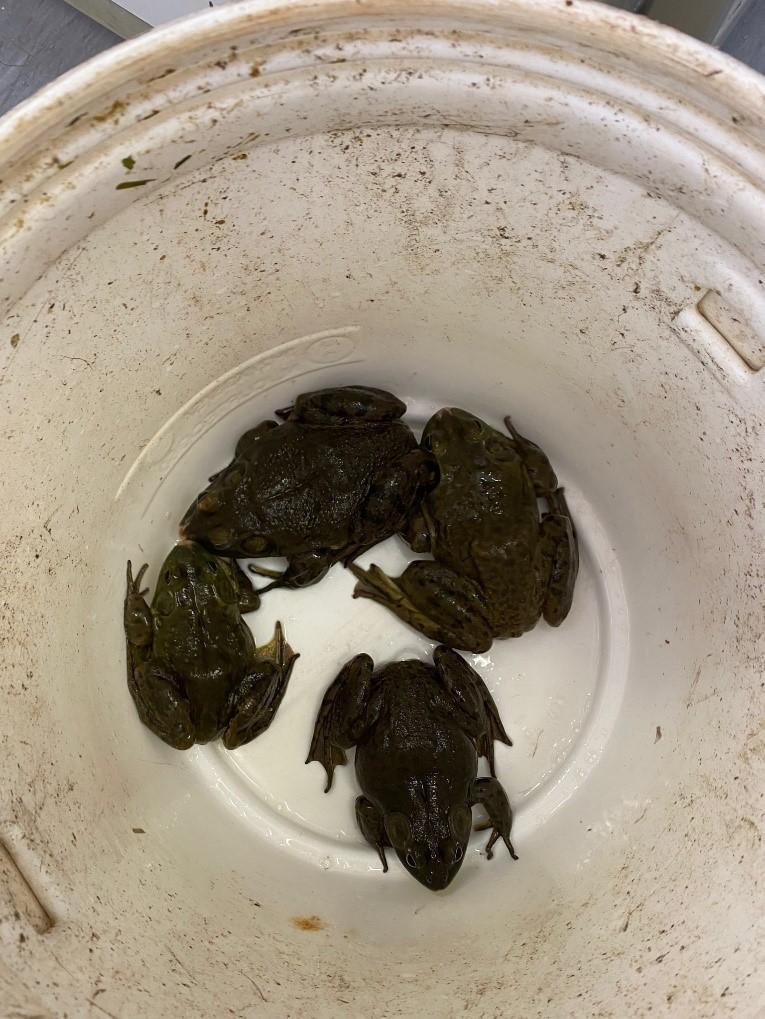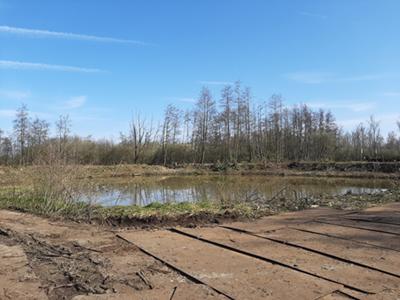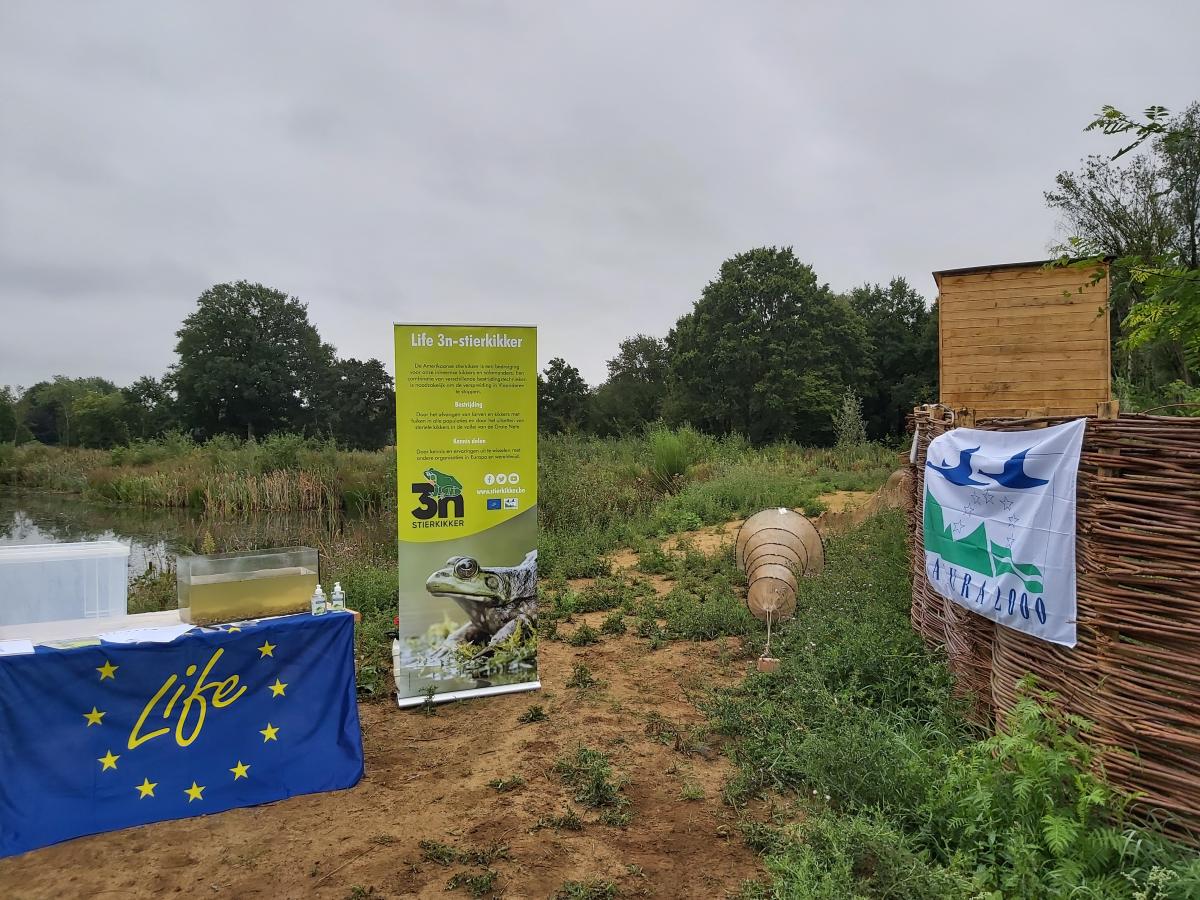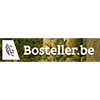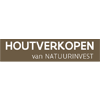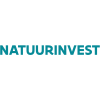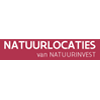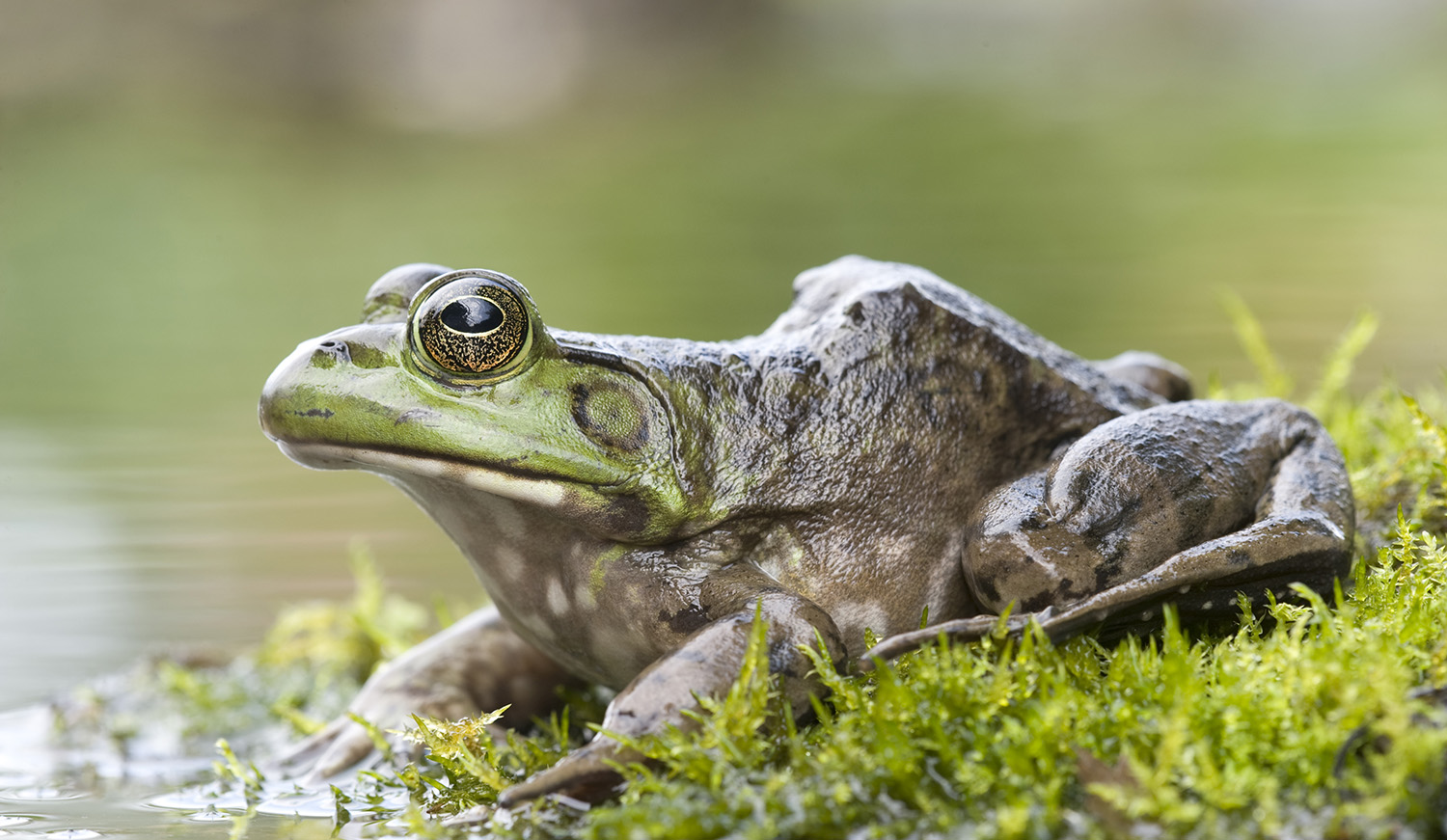
LIFE 3n-Bullfrog
LIFE-3n bullfrog is a European LIFE project, with the main goal of finding a sustainable method to stop the spread of the American bullfrog in Flanders, particularly in the main population located in the valley of the Grote Nete.
Introduction
LIFE 3n-Bullfrog
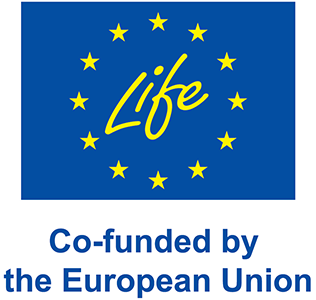
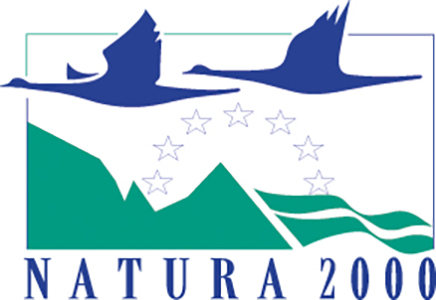
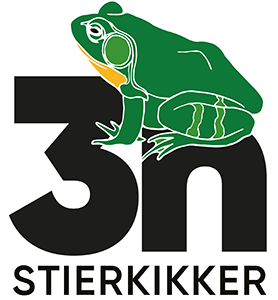
The official title of the project is The sterile triploid method for population control of aquatic invasive fauna: pilot project on American bullfrog. The project combines traditionally used control techniques to stop the spread of American bullfrogs in Flanders with a new technique, namely the release of sterile triploid (3n) frogs. In a triploid frog, every cell contains three chromosones instead of the usual two, making the animals sterile. After years of research, scientists at the PXL University have succeeded in breeding sterile triploid frogs.
The project was officially launched in October 2019 and will run until March 2025. You can follow its progress in our news items, on Facebook or Twitter! Life 3n bullfrog is a collaboration between the PXL University, the Research Institute Nature and Forest, the Agency for Nature and Forests of the Flemish Government and Natuurpunt. The project has received funding from the LIFE programme of the European Union (LIFE18 NAT/BE/001016) and from Antwerp province.
Project area
There are several self-sustaining bullfrog populations currently known in Flanders. These consist of several isolated populations in the municipalities of Kasterlee, Hoogstraten, Huldenberg and Sint-Agatha Rode, as well as a large expanding metapopulation along the valley of the Grote Nete in the Province of Antwerp. This population stretches from Balen in the East, to Lier in the West. It is primarily from this population that bullfrogs are spreading. Logically, the project area is mainly situated within this large metapopulation along the valley of the Grote Nete. In total the project area encompasses 152.000 Hectares, which includes over 400 ponds along more than 50 km of catchment area. Additionally the isolated populations in Kasterlee, Hoogstraten, Arendonk, Huldenberg and Sint-Agatha Rode are also included in the project area.
The first release of sterile bullfrogs will take place in the heart of the population, in the Nature reserve Scheps and close to the Straalmolen in the municipality of Balen. These areas are a part of the Grote Netewoud. Specific netting efforts will also take place in this population to help prevent this population from expanding. These netting efforts use the same techniques as those used for isolated populations.
The map shown below illustrates the currently known populations. Current populations are restricted to the provinces of Antwerp, Limburg and Flemish Brabant. Sightings of American Bullfrogs have been reported in some of the other Flemish provinces, but for now these have remained unconfirmed.
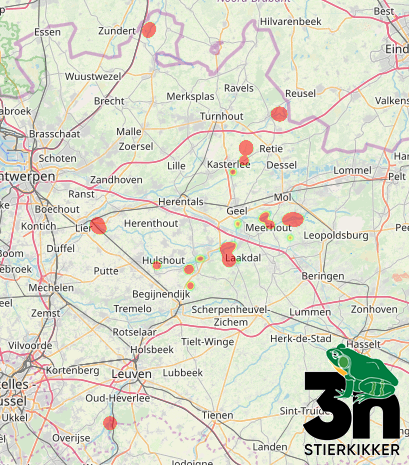
The current range of the American bullfrog in Flanders. A particularly large metapopulation is situated in the valley of the Grote Nete. (source: Gbif.org, 2015- present day)
Goals
As a pilot project, LIFE-3n bullfrog has several ambitious main goals:
- Naturally, the main goal is to test the novel strategy of releasing sterile triploid frogs as a means of population control. Hopefully the technique will help to halt the spread of bullfrogs in Flanders and reduce population sizes in existing populations. This novel technique will always be combined with traditional eradication efforts. After several years of research, scientists of the PXL University have succeeded in breeding sterile triploid frogs. These sterile tadpoles will first be housed in specialized enclosures, where they will develop into juvenile frogs. Later they are transported to a second set of ecnlosures in the Scheps nature reserve, where they can mature into adult frogs and later compete with fertile bullfrogs that are already present. Thanks to careful monitoring of the released frogs by PXL scientists, we will be able to assess how effective the technique is at reducing population sizes of American bullfrogs in Flanders.
- Using sterile animals to control population size is a technique that is already being used successfully with insects. This project is the first global experiment for population management in aquatic vertebrate animals. It is therefore of great importance that the results of this project are shared with other organizations in Europe, so that the technique can eventually be applied in other areas where the bullfrog is a problem.
- Considering this technique is completely new for amphibians, we will investigate possible policy and legal barriers to the use of this technique in invasive species control and its further application for other invasive alien species.
- A final, but certainly no less important objective is to inform the general public about the importance of nature conservation, the impact that invasive alien species can have on nature and the importance of using innovative methods to combat invasive alien species. Getting public support for this project and other future projects is essential for the viability of nature conservation, both inside and outside Belgium.
Where does the bullfrog come from?
As the name suggests, the American bull frog hails from America. The bullfrog was originally only found in the central and eastern parts of the US and southeastern Canada, but has now spread to other, more western states. In its native range, the frog occurs in a wide variety of habitats such as swamps, lakes and large river arms, but the species is also common in forests, gardens and parks. The species is strongly bound to water everywhere. Partly because of this, the natural enemies of the bullfrog mainly consist of aquatic animals such as alligators, snapping turtles and American otters. Raccoons have also been observed to eat bullfrogs and their tadpoles on occasion.
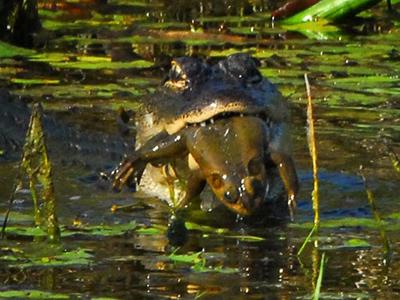
An alligator eating a bullfrog
Because of its size, the American bullfrog is considered as a good source for frog legs. Thanks in part to this trade in frog legs and the professional breeding of bullfrogs that accompanies it, the American bullfrog has spread to many other parts of the world. Unnoticed eggs piggybacking with aquatic plants or fish and trading as a curiosity in aquaculture bullfrogs have greatly helped the species’ spread to many other areas. The American bullfrog is currently present in the American archipelago of Hawaii, southern North America (Mexico), South America, Europe and Asia. The map below shows where the bullfrog originates, and in which areas the species is present as an invasive alien species.
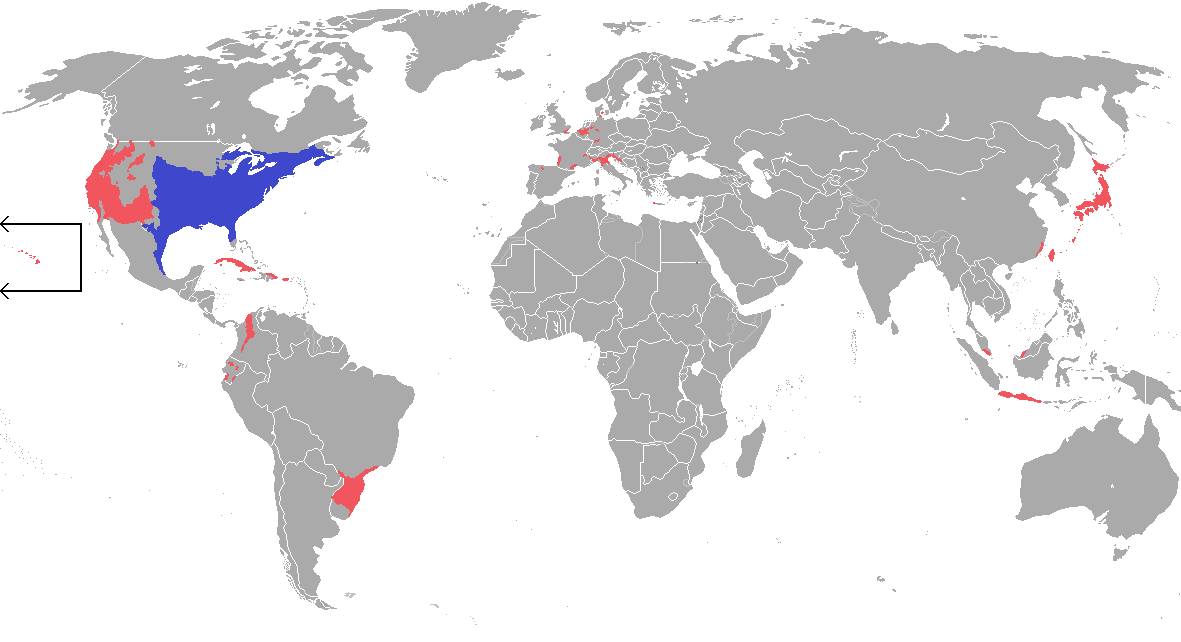
The current range of the American bullfrog. Blue zones are considered to be the original, natural range and red zones are areas where bullfrogs occur as an invasive alien species.
An invasive alien species in Flanders
The American bullfrog is considered an invasive alien species in Europe. To speak of an invasive alien species, we mainly look at two things: 1) is the species able to establish itself and multiply here and 2) is the species responsible for nuisance or damage.
The American bullfrog was imported to Europe from America as a live fish stowaway for fish stocking, but was also commonly imported for aquaculture, landscaping, or even angling. In the early 1990s, bullfrog larvae were commonly found for sale in many pet stores and garden centers for keeping in ponds or aquariums. Tens of thousands of tadpoles have ended up in our regions in this way. But tadpoles develop legs, and the young bullfrogs have colonized the surrounding areas from the gardens where they ended up as tadpoles. This often involves fish ponds, recreational ponds and other nutrient-rich waters that are typically heavily disturbed by human activity. Some of the frogs and larvae were probably also moved by private individuals from their pond or aquarium to the wild. Since then, bull frogs have proven that they are more than capable of reproducing in Flanders, causing their range to have expanded considerably since their original introduction.
In its native range, the American bullfrog has natural enemies such as alligators, snapping turtles, American otters and raccoons. However, comparable enemies do not exist in our regions. Hence, bullfrogs that find their way into Flemish nature encounter little resistance and can reproduce unhindered. In addition, different stages of the bullfrog's life are apparently distasteful to many of our natural predators of frogs, although the tadpoles are occasionally eaten by predatory fish and waterfowl. Surprisingly, the only real bullfrog predator in our region is the bullfrog itself, as the species is highly cannibalistic. However, the impact of cannibalism on bullfrog populations is very limited, as a single female can lay up to 20,000 eggs.
Bullfrogs are very large and voracious frogs. The species is known for having an insatiable appetite and their uncanny ability to eat just about anything that fits into their mouths. Insects, but also frogs, toads, salamanders, fish, chicks of waterfowl such as moorhen and various duck species, mice and other small mammals are on the menu. When bullfrogs arrive in our regions they tend to occupy ponds where, due to their voracious nature, they quickly begin to dominate those ponds. The introduced bullfrogs swiftly start eating our native amphibians such as toads, green and brown frogs and various salamander species. In addition, young bullfrogs eat the same insects as our native amphibians, which creates further competition.
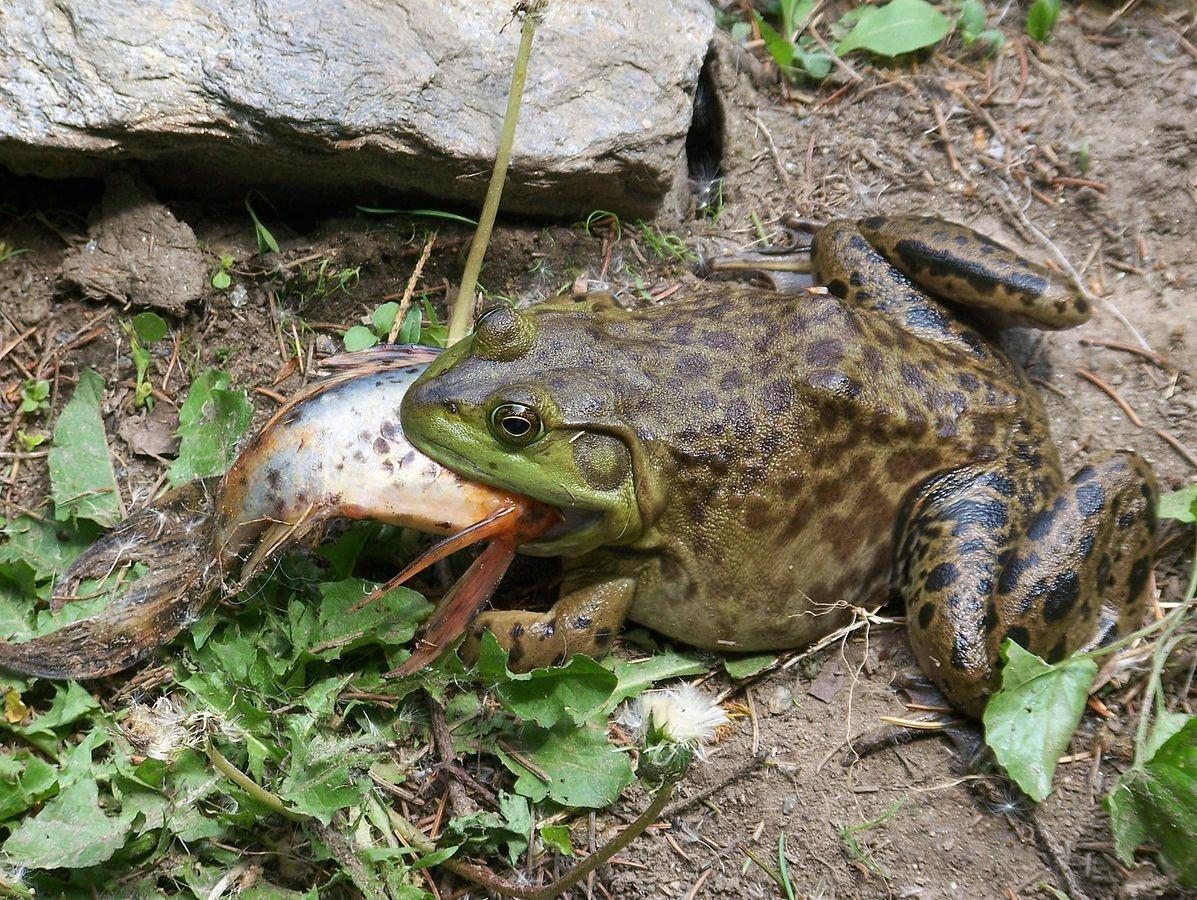
A bullfrog attempts to eat a fish it caught.
On top of eating our native fauna, the bullfrog is also a carrier of several diseases, including the chytrid fungus which is responsible for much of the worldwide decline in amphibian species. The species can also carries the rana virus which, much like chytrid, can spread rapidly and cause high mortality in amphibian populations. Bullfrogs themselves appear mostly resistant to by these pathogens, but our native species, such as the rare midwife toad and fire salamander, become infected through contact with infected water bodies and die from the diseases. In this way, the introduction of even a single bullfrog into a pond can cause a rapid decline in the local native frog populations.
For these reasons, the bullfrog has been included in the international and European list of '100 Worst Invasive Species'.
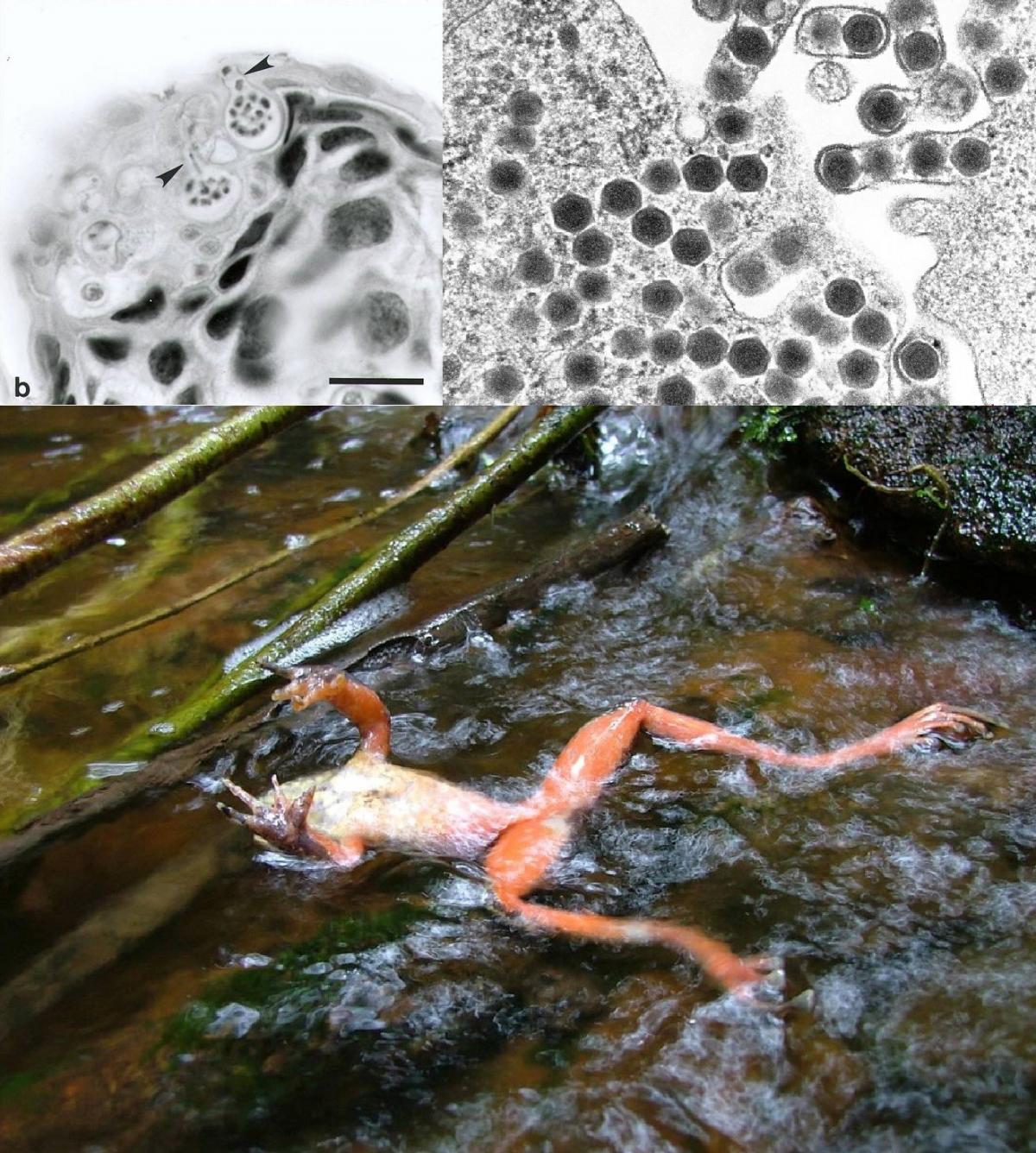
Top left: a microscopic section of frog skin infected with chytrid; Top right: a microscopic slide of frog tissue containing lots of rana virus; Bottom: a victim of chrytrid infection. New infectious spores emerge from deceased animals, infecting other amphibians through contact with infected water and wreaking havoc on amphibian populations.
Several large populations are known in Flanders, particularly in the Province of Antwerp. Especially in the valley of the Grote Nete, where the largest population of Flanders is located, the presence of bullfrogs is causing declines in native frogs and salamander populations. This large metapopulation expands their range upstream and downstream in the valley of the Grote Nete every year. Traditional control with existing techniques, such as placing fykes and draining ponds, are therefore no longer considered sufficient.
How can we get rid of this invasive frog?
Traditional control measures for the American bullfrog consist of a combination of setting fykes to trap frogs and tadpoles, shooting juvenile and adult frogs, and draining ponds to eliminate their habitat. Single fykes anchored on the bank are often used to catch frogs, while double fykes are used to trap the larvae. A single fyke consists of a long net called a “leader” that opens into a series of funnels that lead to a final trapping compartment. By anchoring the leader on the bank, all frogs that swim by are led to the funnels, where they are then caught. A double trap has the same structure, only there are funnels on each side of the leader. These double traps are usually set up away from the banks in the ponds to mainly catch tadpoles. Although adult frogs can be caught with traps, the catching efficiency tends to be relatively low. Of course draining a pond is the most effective way to eliminate frogs from a pond, but this is not always feasible or desirable and also only works as a control if the migrating frogs are also caught to ensure that they do not occupy neighboring ponds.
This video illustrates how these fykes are usually set up and used.
Unfortunately, these existing techniques such as placing traps and emptying ponds, are not sufficient anymore to halt the spread of bullfrog populations in Flanders. The LIFE 3n-Bullfrog project aims to combine the aforementioned traditional control measures with a new method to stop the spread of the American bull frog in Flanders.
For the isolated populations in Kasterlee, Hoogstraten, Arendonk, Sint-Agatha Rode and Huldenberg, the traditional control measures with fykes will be continued. In these populations, these methods are sufficient to control bullfrog numbers. In Hoogstraten, for example, the population has been virtually wiped out. In subsequent years, aftercare is essential to prevent new reproduction from occuring and to remove individuals that may have been left behind.
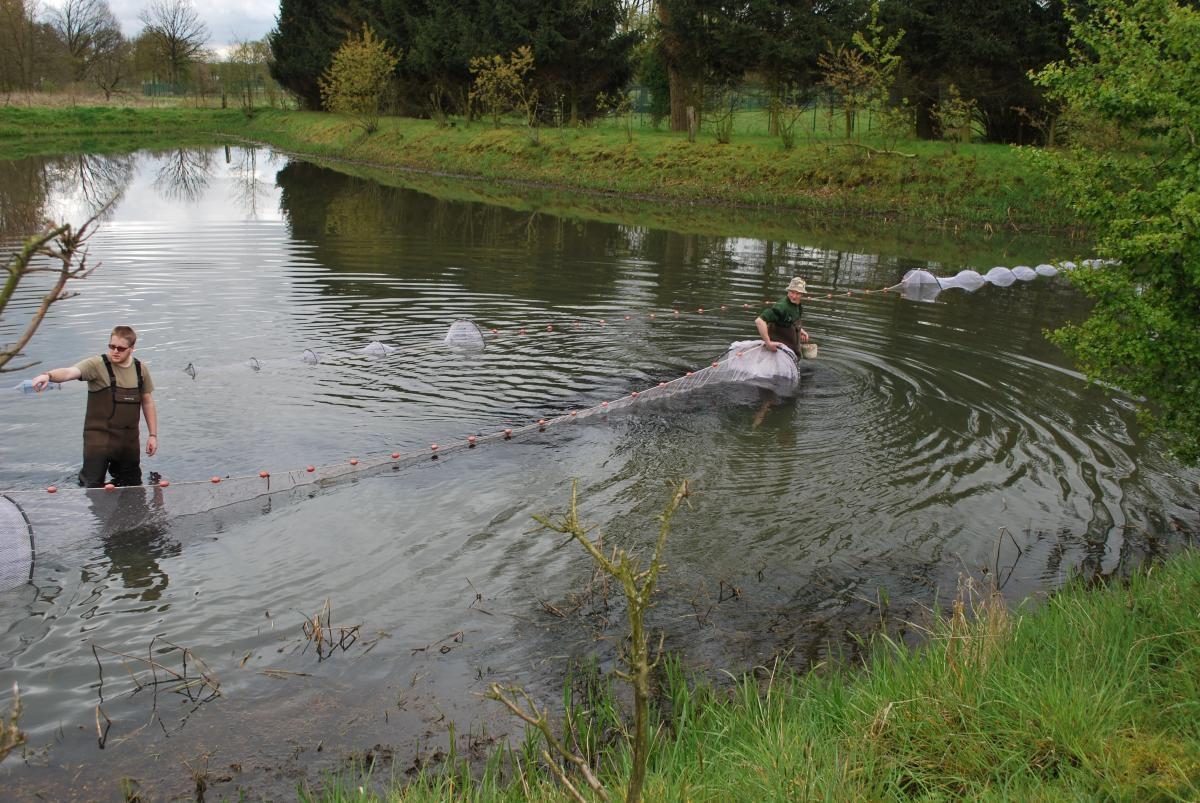
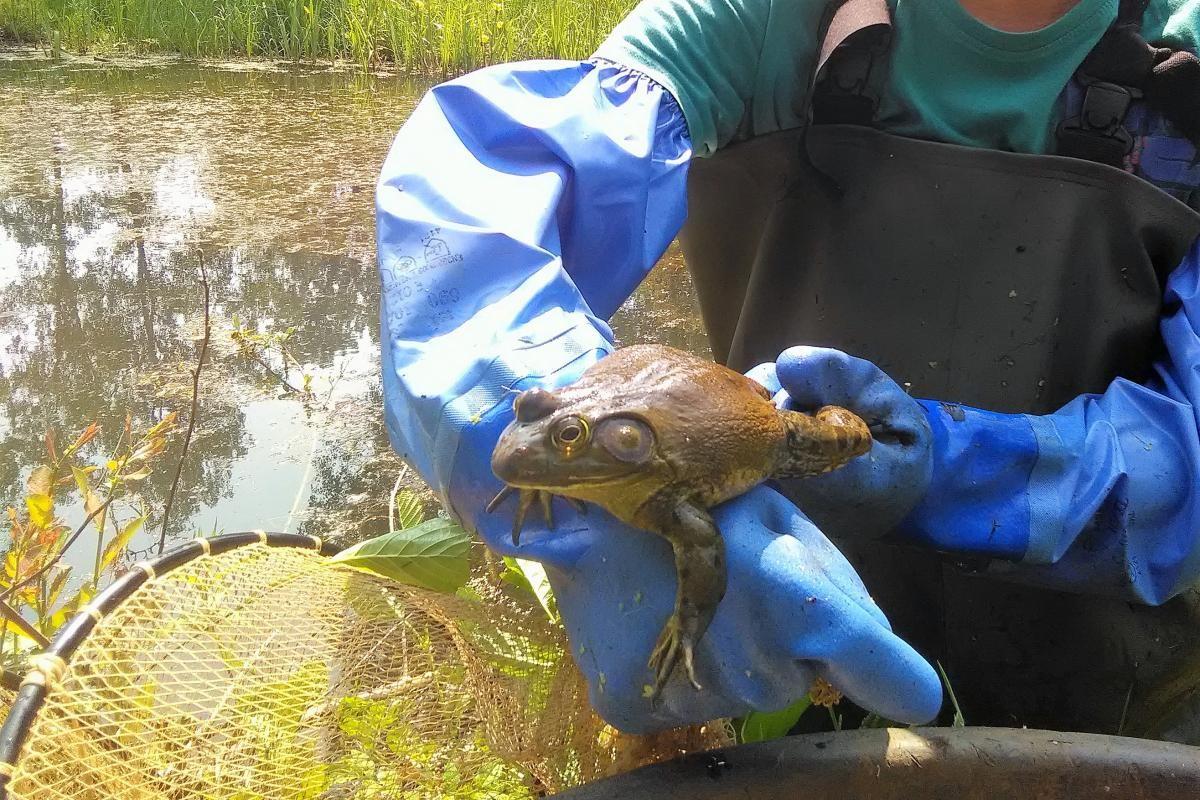
Left: double fykes are set up unanchored in ponds to catch tadpoles. - Right: an adult bullfrog, caught using fykes.
In the valley of the Grote Nete, where the smaller populations of American bullfrogs are linked by a network of ponds, traditional control techniques are no longer sufficient. Here, the Life project will experiment with releasing sterile male frogs in enclosed ponds. Release of sterile males is a technique (appropriately called sterile male release technique or SMRT) that is currently already used for the control of insects such as mosquitoes and parasitic flies. However, this project is the first test to apply this technique to invasive amphibians. After several years of research, scientists at PXL University have succeeded in breeding sterile specimens with fertile frogs, which were caught using fykes. You can find out how this is done on our Facebook page. To create sterile frogs, fertilized eggs of the captured fertile frogs are briefly put under high pressure. This causes the developing embryos to become triploid. A triploid frog has three sets of chromosomes in each cell instead of the normal two. Because these frogs have an abnormal number of chromosomes, they cannot reproduce and are thus effectively sterile. These sterile embryos then develop into bullfrog tadpoles, which are released into enclosed breeding ponds in Balen. Here the tadpoles can safely develop into young frogs, after which they are transferred to other enclosed ponds in a second site in the Scheps nature reserve. In this second set of ponds the young frogs grow into adult frogs which are then able to compete with the present feral fertile frogs. This technique is currently considered the most sustainable and animal-friendly option we have to control American bullfrog populations in Flanders. Triploid sterile males will attempt to fertilize clutches from feral bullfrogs, which of course fails. If there are enough sterile animals present, most of the clutches will be fertilized by sterile animals. As a result, fewer tadpoles hatch each year and fewer frogs grow into adults. If enough clutches fail in this way for several years, it is even possible that no new frogs make it to adulthood. This way the population growth will stop and the bullfrog populations will stop expanding in Flanders.
Spotted a bullfrog?
However, eradication or restoration efforts in certain habitats are useless if new bullfrogs are introduced into nature at the same time. Preventing new 'introductions' is always better and cheaper than eradicating populations afterwards. It is therefore important to keep track of new observations of American bullfrogs. Have you seen or heard of an American bull frog? Then pass it on at www.waarnemingen.be.
You can quite easily distinguish the bull frog from our native frog species if you look at the right characteristics. Their call, size, eardrums, throat and back are distinguishing characteristics. Bullfrog tadpoles are more difficult to distinguish from their native counterparts, but their size is usually a good indicator.
The call is by far the easiest characteristic to recognize American bullfrogs. The male bull frog bellows like a bull, hence the species’ name. The sound is sometimes described as if someone shouts the word “rum” into an empty barrel. Please note: 'green frogs' such as the edible frog and the marsh frog can also make a lot of noise. They are therefore sometimes confused with bullfrogs. The sound can also sometimes be confused with the call of the bittern.
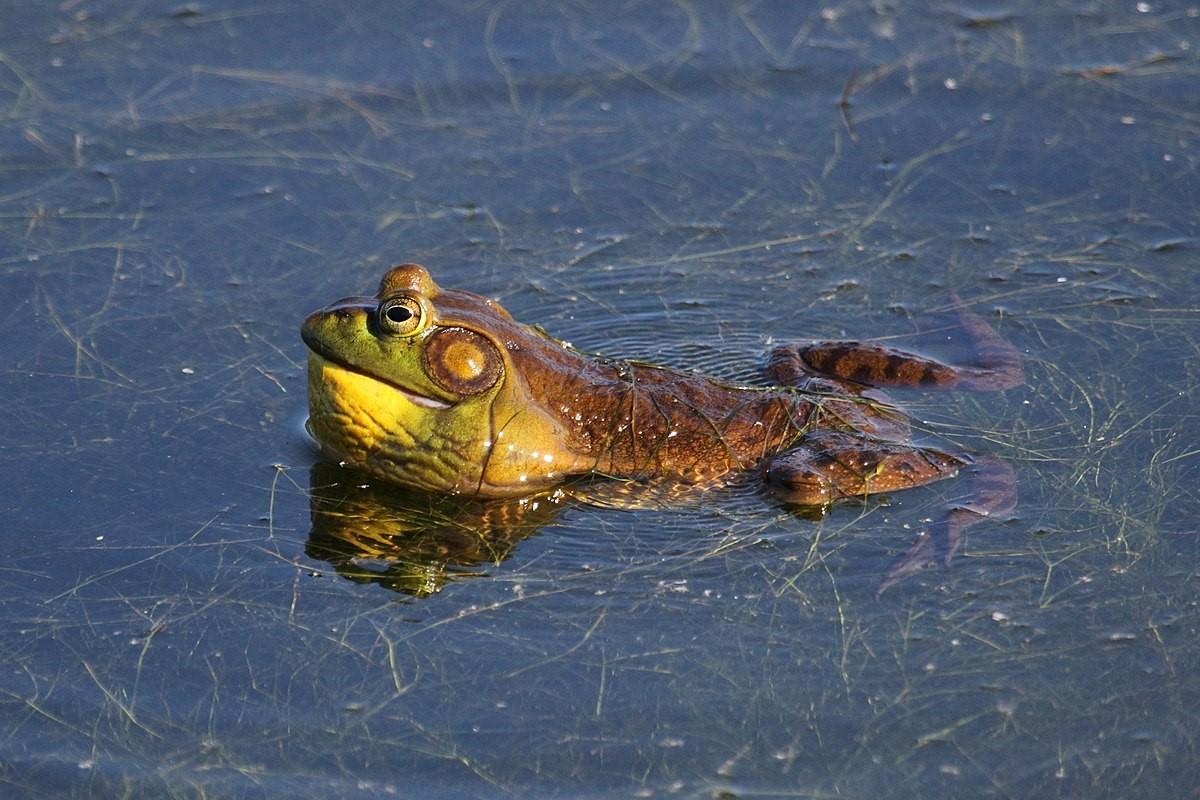
A calling male bullfrog. The yellow throat and large eardrums are clearly visible and are characteristics by which the species is easily identified.
Bull frogs are by far the largest frogs you can find in our regions. Adults can reach a size of more than 20 cm, with a weight of more than 500 g. In comparison, the marsh frog (Pelophylax ridibundus), our largest native frog, is a lot smaller with an average size of 10 to 14 cm.
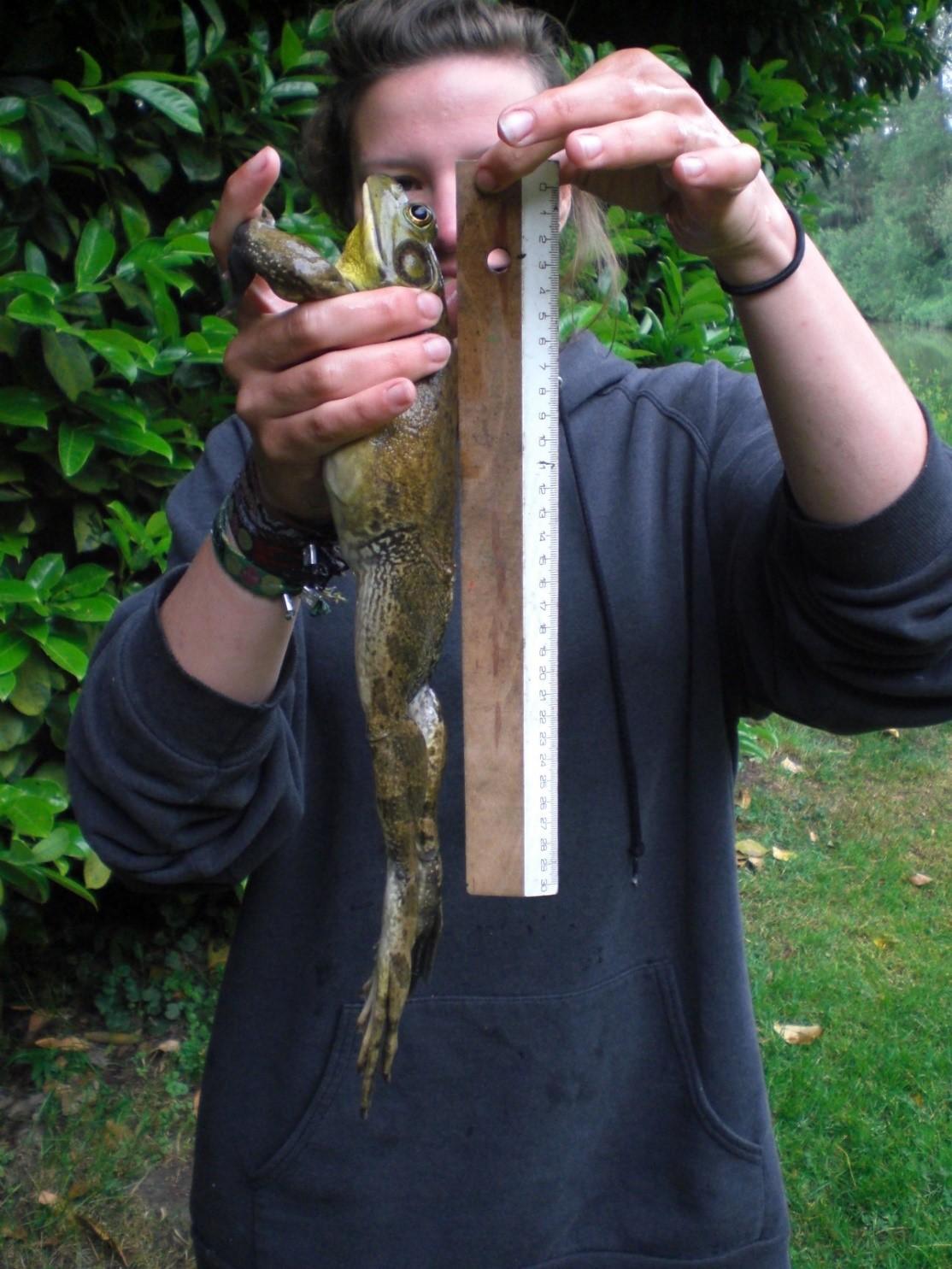
A sizeable bullfrog. Animals of this size are pretty common.
The other aforementioned characteristics are a bit more subtle, but still quite easy to recognize for the trained eye. Bullfrogs have a large tympanic membrane, which is about the same size as the eye in females, and much larger in males. In our native frogs, the eardrum is always the same size or smaller compared to the eye. Bullfrog males have a single throat sac, which is yellow in color. Native green frog males have two cheek sacs. The moor frog, common frog and European tree frog also have a throat sac, but this is never colored yellow and you will not easily mistake these species for a bull frog. Finally, bullfrogs usually have an olive green to brown back, with no dorsal ridges (raised lines on the back) or longitudinal stripes. Native green frogs have two dorsal ridges and almost always a lighter longitudinal stripe centrally on the back.
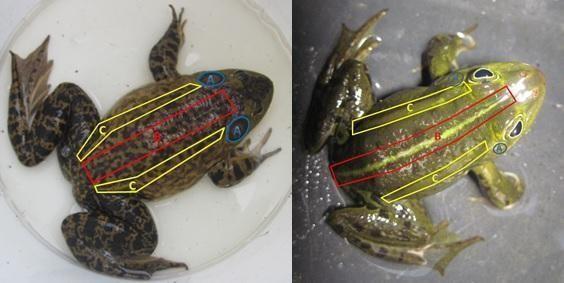
On the left a bullfrog, and on the right a native frog. The notable characteristics for species identification are highlighted: eardums (A), longitudinal stripe (B) and dorsal ridges (C).
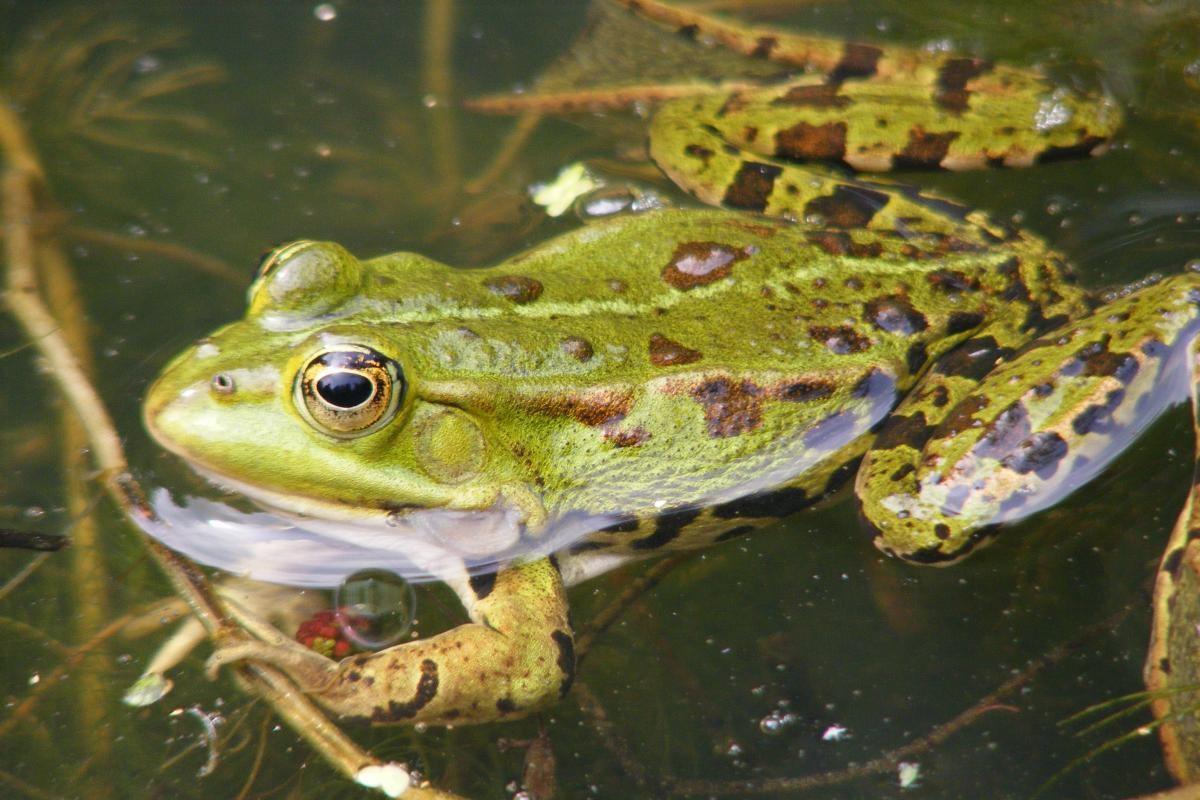
A native green frog, with clearly visible dorsal ridges and longitudinal stripe. The eardrum is also smaller compared to the eye.
Tadpoles are always harder to identify correctly. Here the only really useful feature is their size. Bullfrog tadpoles become very large, up to 16 cm long. It normally takes two to three years for a bullfrog tadpole to develop into a frog. They overwinter in the water near the bottom. Again, it is important not to confuse bullfrog tadpoles with the tadpoles of the green frog, which can also take up to two years to become a frog but typically remain much smaller.
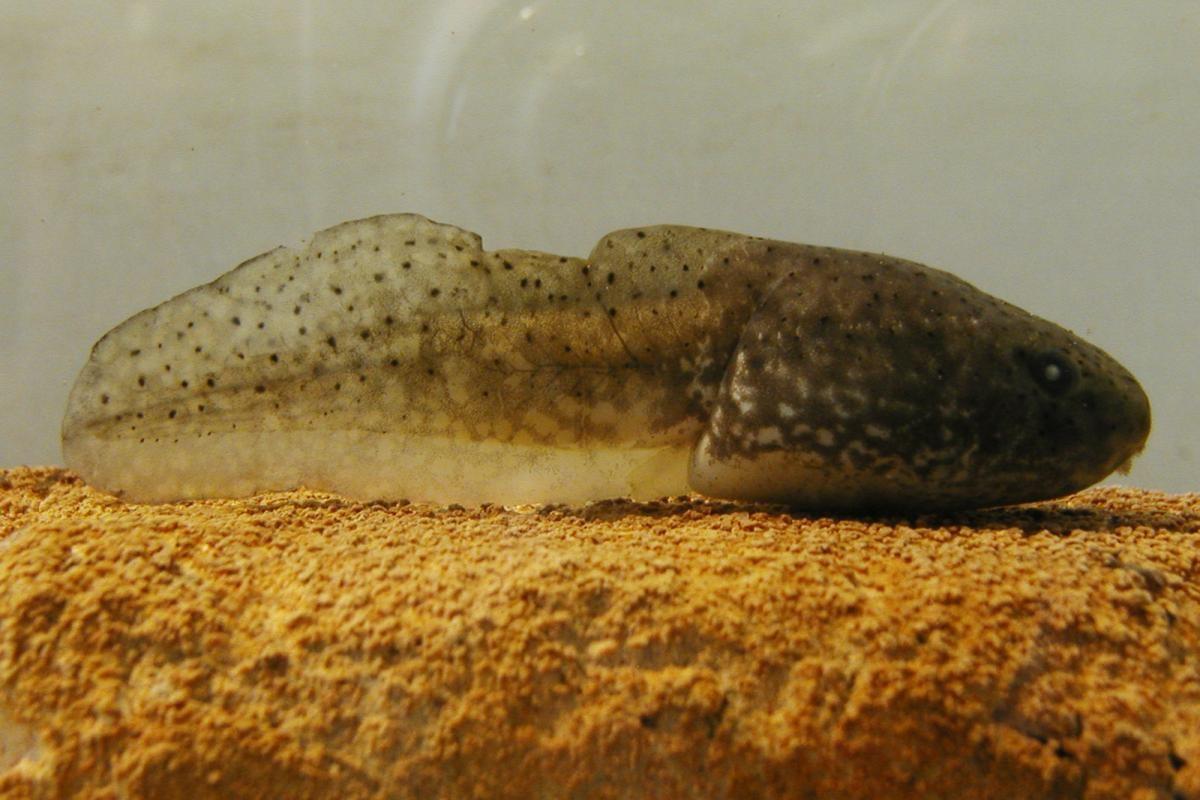
A tadpole of an American bullfrog
Want to know more about American bullfrogs?
News
17 March 2023
In this first video of our 4-part series, we briefly describe the issues that arise when trying to control populations of the invasive American bullfrog. We also describe one of the most promising solutions, being the use of sterile triploid animals, which is of course the focus of the Life 3n-Bullfrog project.
In our second video of the series, we take a deeper look at the laboratory procedures that are needed to breed sterile triploid frogs. These sterile individuals are the basis for the sterile triploid method, which will hopefully be used to control the American bullfrog populations in Flanders.
In the third video of the series, we’d like to focus on the more traditional approach to catch American bullfrogs. So far the most effective method has been the use of fykes, both single and double fykes. Although these are not difficult to set up, it is important to do this the correct way to ensure the highest possible effectivity in catching American bullfrog adults, juveniles and/or tadpoles.
In the fourth and final video of the series, we discuss one of the most important aspects of bullfrog control efforts: biosafety. Aquatic environments are particularly susceptible to infections with pathogens and invasive species, so it is of the utmost importance to disinfect all used equipment before storage or before moving between sites.
12 january 2023
The American bullfrog is not the only species that poses a problem for the Flemish biodiversity. The African clawed frog can also cause great damage. In Messines, they have started an eradication programme for the species.
13 december 2022
The #LIFEprogramme celebrated its 30th anniversary this year! LIFE is the EU's funding instrument for environment and climate actions. Our project receives financial support through the LIFE program of the European Union.
27 september 2022
Our expo about the American bullfrog, the threat it poses to our environment and how we want to get rid of it is making its rounds in various cities and municipalities. It is currently displayed in De Klapekster, the visitor center of Vallei van het Merkske. If you're in the area, be sure to stop by during opening hours.
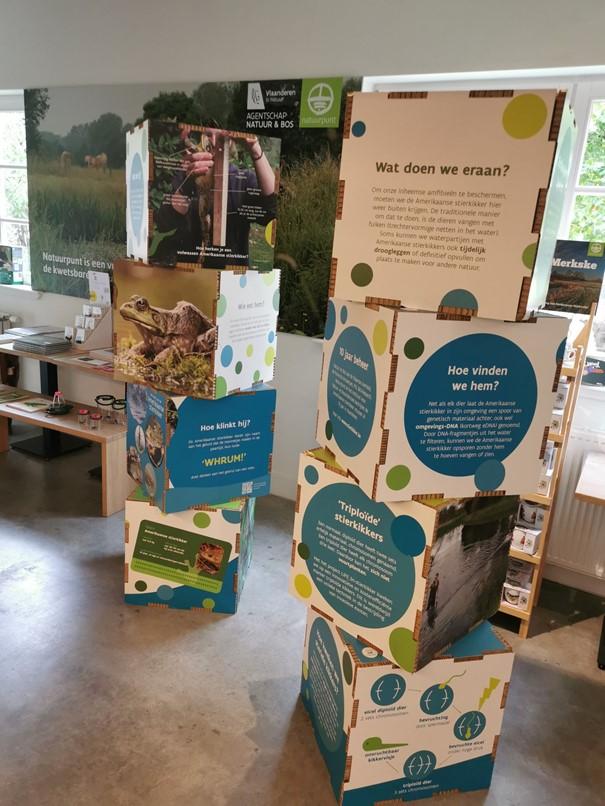
3 august 2022
The American bullfrog is listed on the 100 "Worst Invasive Species" list, and for good reason. A new study in Scientific Reports has calculated the economic damage that invasive species are causing to the world. The American bullfrog was found as one of the most harmful species, together with the brown tree snake.
24 june 2022
There was a lot of press interest today when we were releasing the sterile bullfrog larvae in the fenced ponds in Balen. These larvae will grow into frogs within these enclosures, after which they can be used to compete with the local fertile American bullfrogs.
Because mating with sterile animals results and no fertilization, many clutches will fail to develop. As a result, the number of American bullfrogs will decrease without the need for major eradication campaigns. That is why this technique is currently considered the most sustainable and animal-friendly option we have to eradicate American bullfrog populations in Flanders.
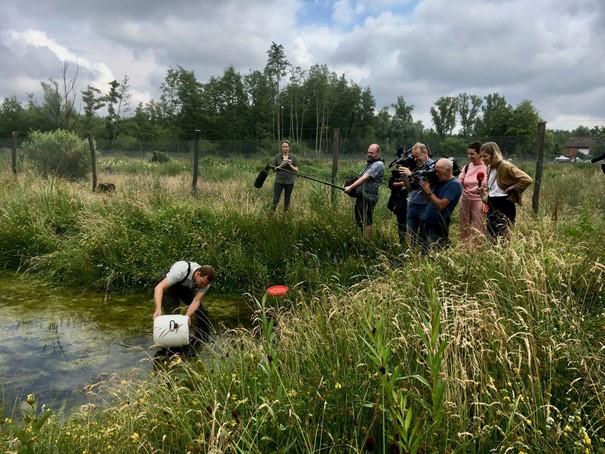
23 june 2022
Today we organized a training day in Balen near the Straalmolen for the control of adult American bullfrogs using air rifles. If there are only a few individuals present in a pond, it is much more efficient to shoot them than to place traps. Employees of Natuurwerk vzw and de Winning vzw who are in possession of a valid hunting permit were trained by the experts of the ANB. Within this LIFE project they are responsible for the active control of the bull frog with traps and now also using air rifles.
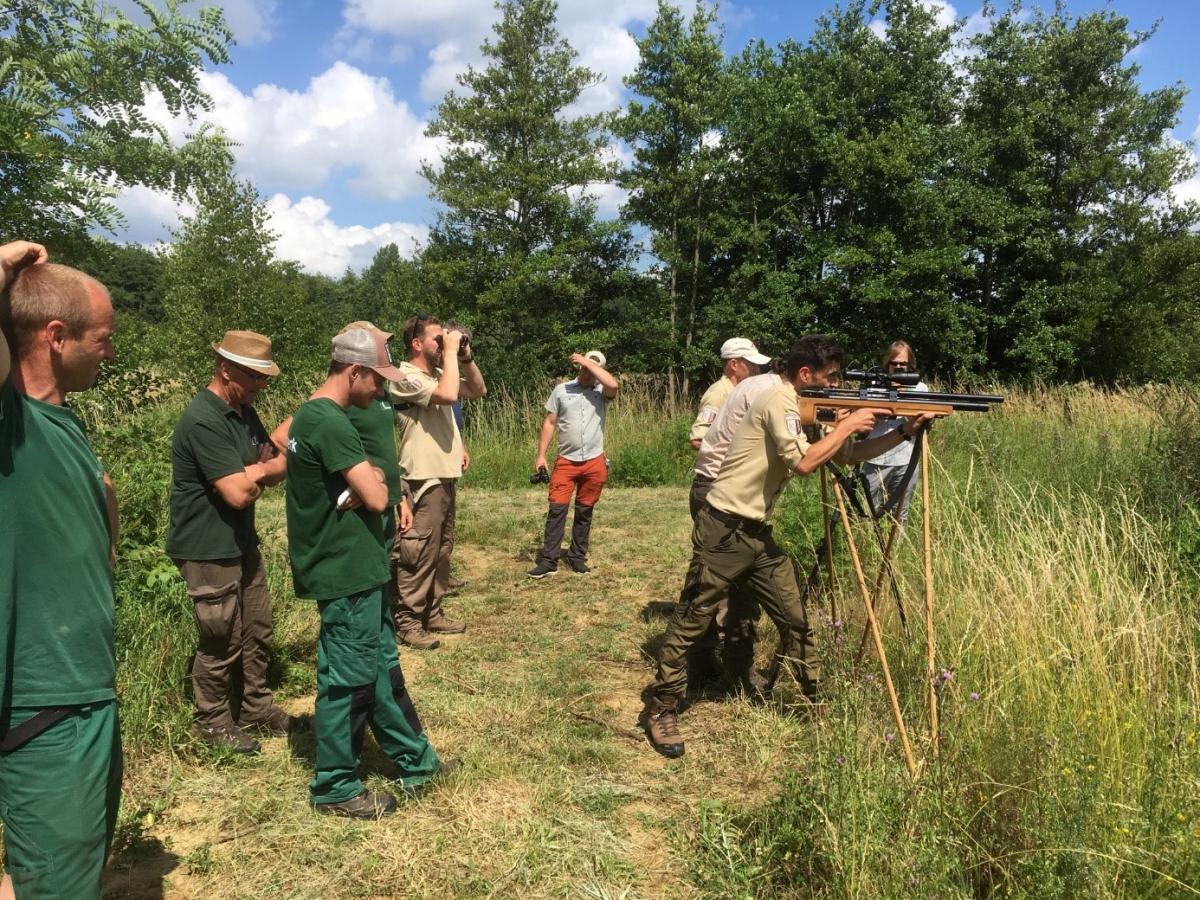
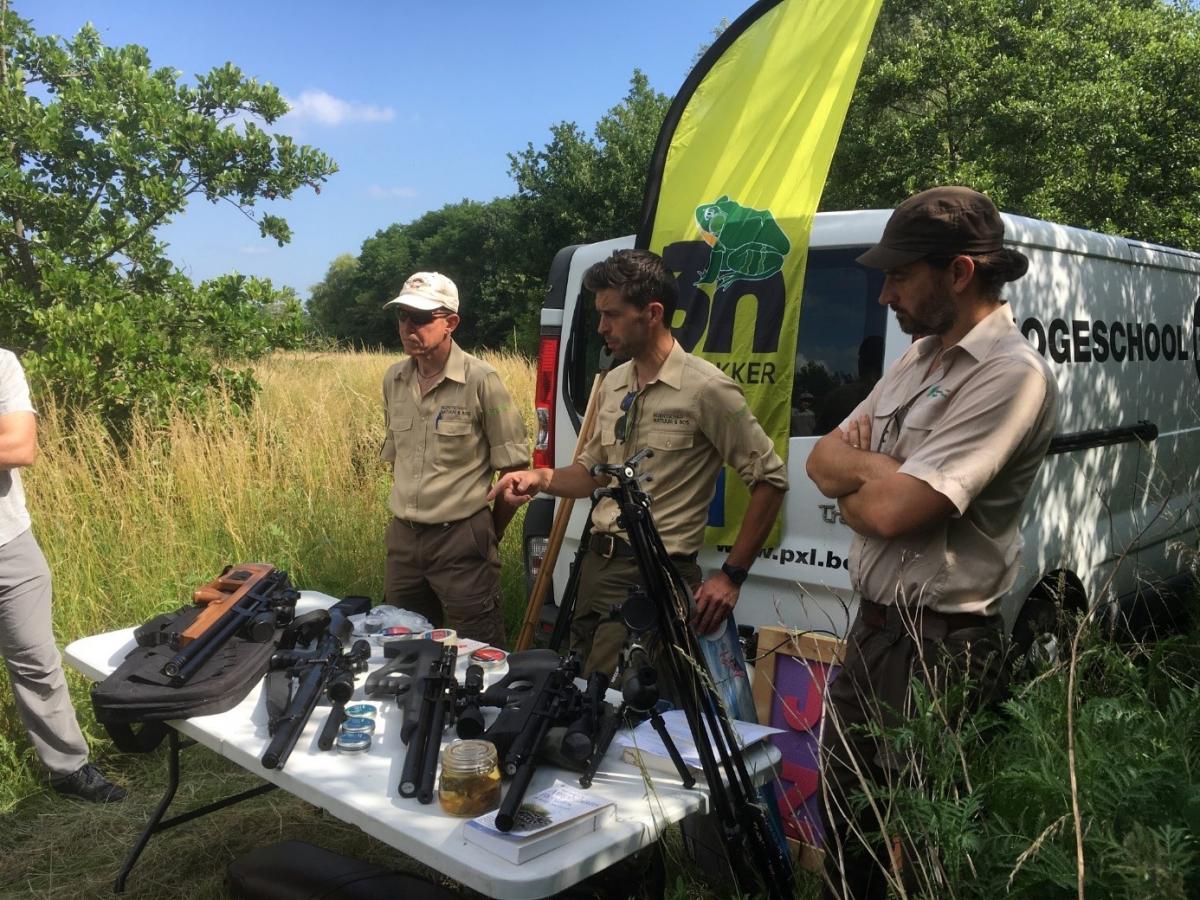
15 june 2022
Today recordings are taking place for a report about the active and passive control of the American bullfrog. This will be used to familiarize our foreign partners with our approach in Flanders. PXL Bio-Research meets PXL Digital Learning!
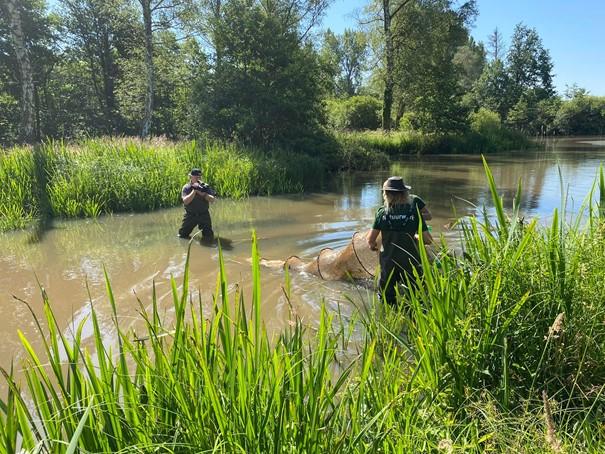
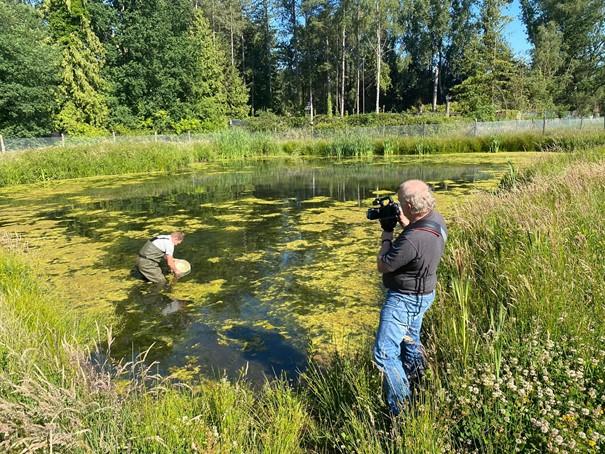
7 june 2022
Abundant rain and soaring temperatures, bullfrogs love it and females start searching for a suitable partner in the ponds. This increase in activity could also be observed in our traps this weekend. Love is in the “bullfrog” air.
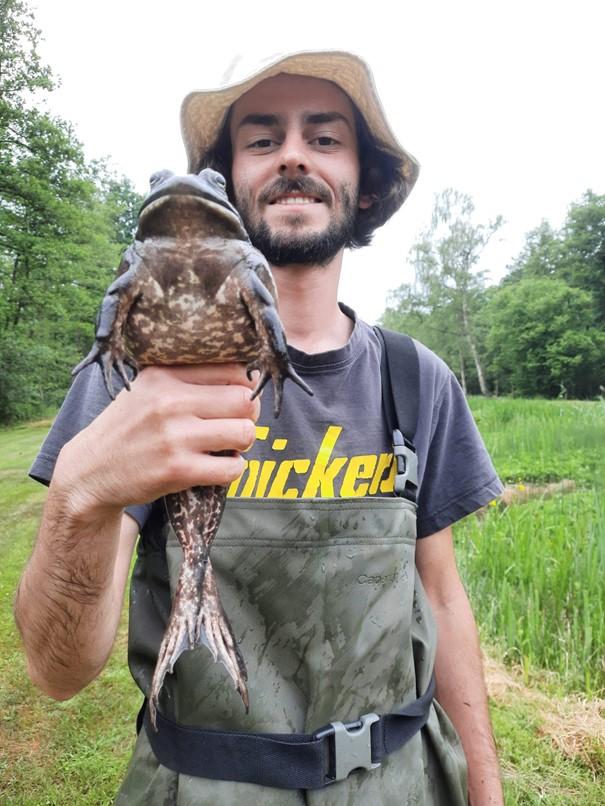
27 may 2022
To maximize the chances of survival for the sterile bullfrog larvae, they are transferred to a natural pond after 10 days in the lab. The pond is free of fish and other bullfrogs and surrounded by a grid. In this enclosure they will continue to grow into small sterile frogs. The first larvae of the culture were just released. All they need to do now is graze on the algae present and grow!
22 may 2022
Today is the International Day for Biological Diversity. By eradicating the American bullfrog from our ecosystems, we can give other species more and better opportunities. Curious how we plan on achieving this? Then go out today with a guide in Griesbroek.
18 may 2022
Bullfrog season has started again! The trapping efforts of the social economy companies Natuurwerk vzw and Natuur-en Landschapszorg vzw are gradually reaching cruising speed. Our breeding efforts of sterile frogs in the lab follow suit, some females have already deposited eggs via hormone stimulation, which we now use to produce sterile American bullfrogs.
6 may 2022
May 21 is European Natura2000 Day. This year marks the 30th anniversary of Natura 2000 and the Life program. With the 'Nature's birthday' campaign, various outdoor activities in both Flanders and Wallonia are being organised between 8 and 31 May. All information about the different activities can be found at www.denatuurisjarig.be.
Life Bull Frog is also participating. You can go out on Sunday 22 May with a guide in the Griesbroek or choose our walk via the digital app Route You.
28 april 2022
Thanks to the sunny and warm weather, the vegetation around our breeding ponds had grown considerably and was in need of a serious trimming! As there are currently no young frogs hopping around yet, we were able to mow carefree. In future mowings, we will have to restrict mowing to the inactive period of the frogs and maintain a minimum height of 30 cm, to ensure that we don’t injure young frogs.
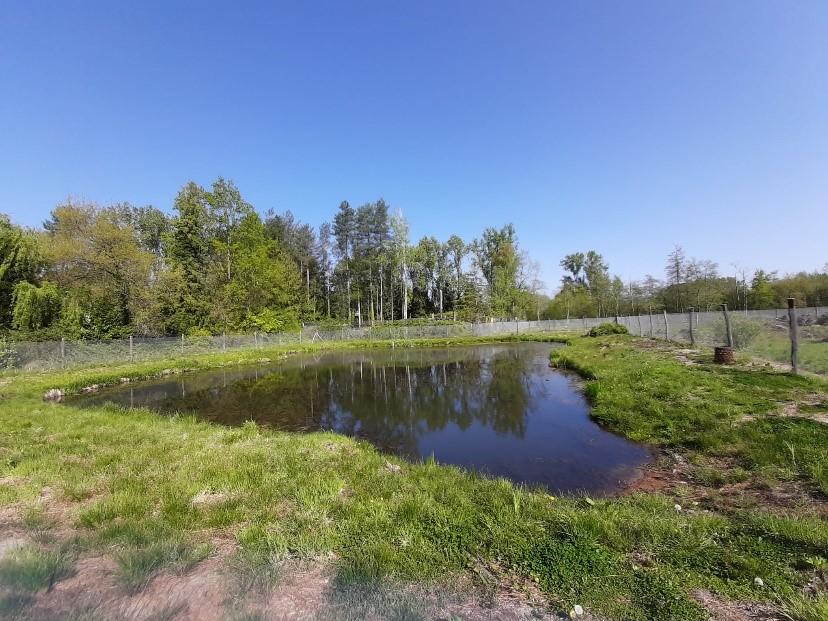
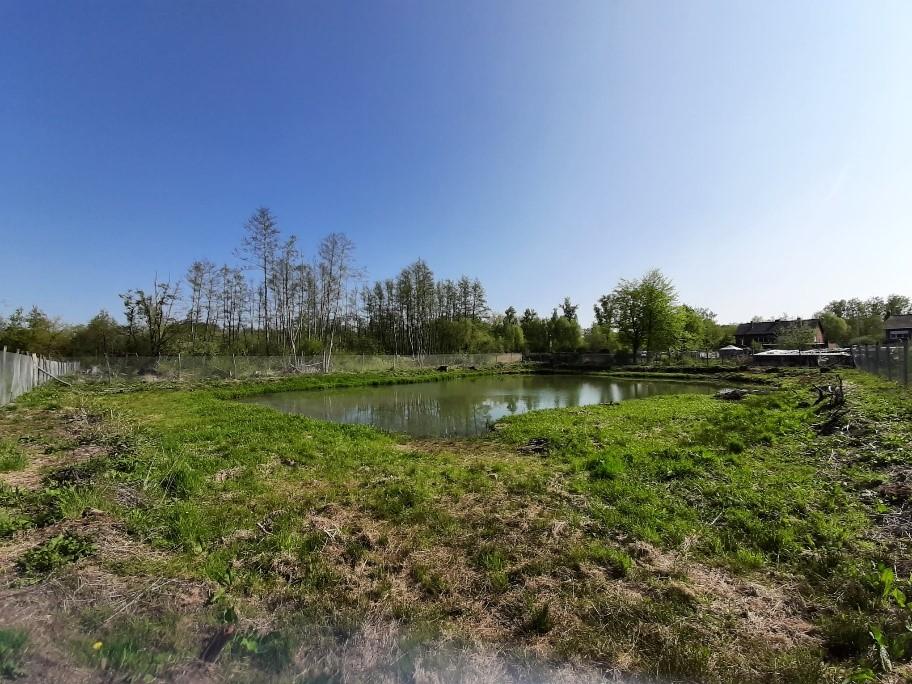
24 april 2022
From 19 to 23 April, the International Congress on Invasive Aquatic Exotics (ICAIS) took plawas being held in the Thermae Palace Hotel in Ostend. Naturally, LIFE 3n-Bullfrog was also present with a lecture about our new management insights and the application of the Sterile-Triploid-Method (STM) for the passive control of these unwanted species.
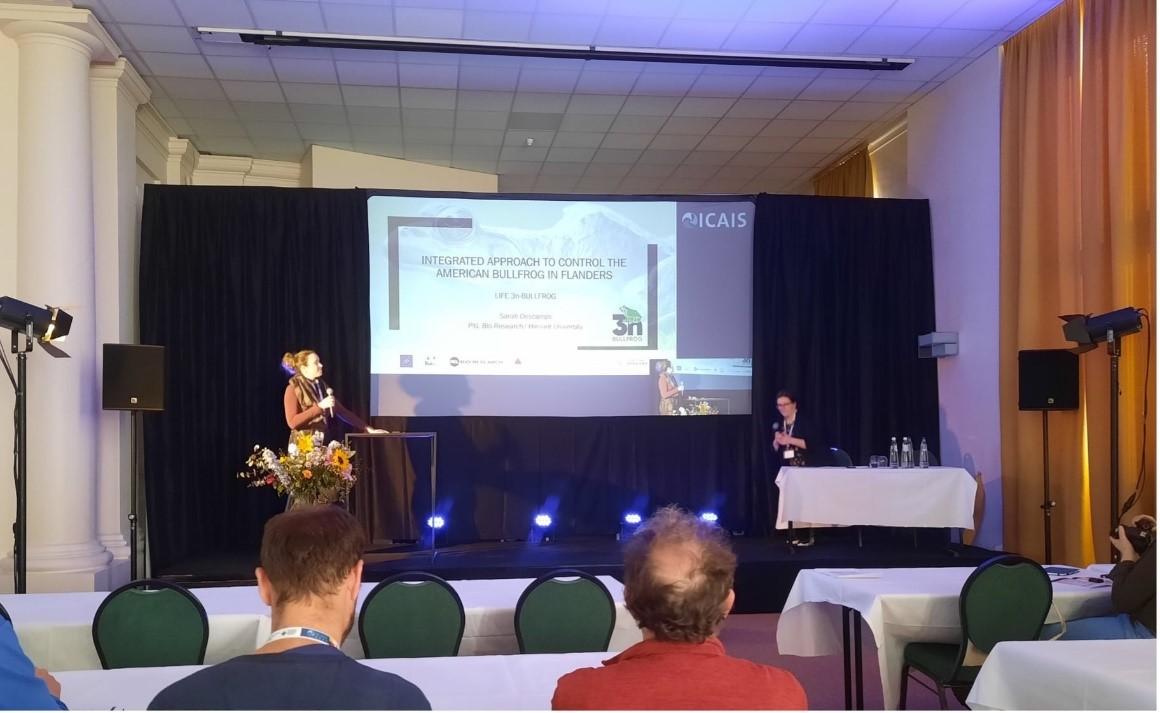
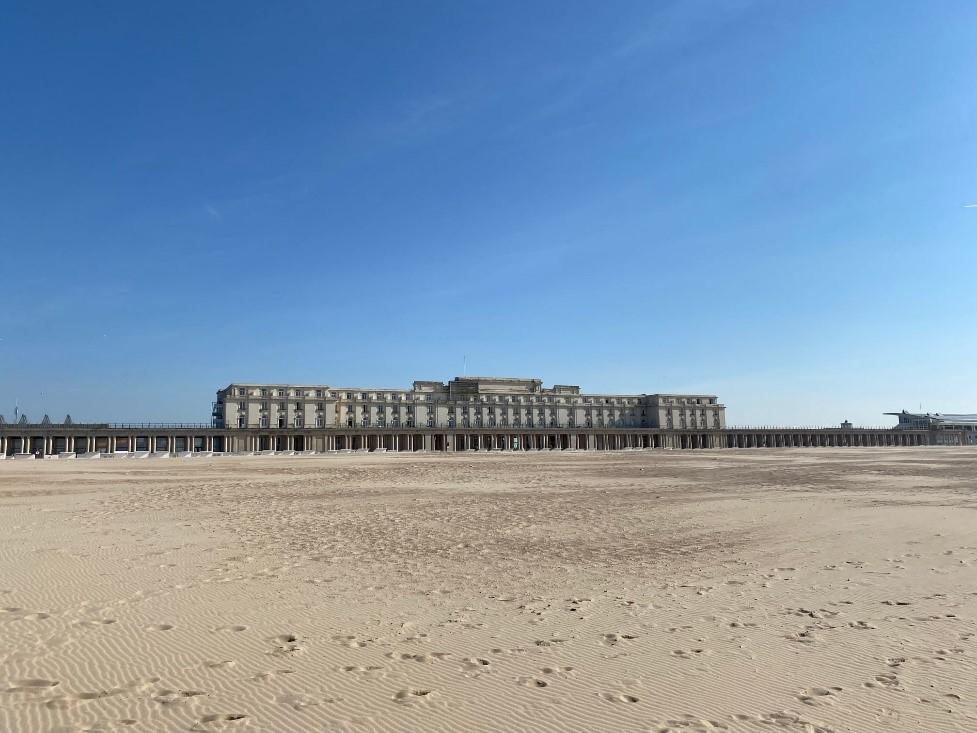
13 april 2022
Thanks to various measurements of the water since the release of our tadpoles, we know that the water quality in our pond is optimal. The water is crystal clear and many aquatic plants and algae are present. These should provide more than enough food for our tadpoles once they wake up from hibernation. And hopefully this won't take long with the rising temperatures.
31 march 2022
After a full week of pumping and cleaning, the ponds are almost ready for this year’s first batch of tadpoles. Now it's just a matter of waiting for the water level to return to normal. Our removal of the water unfortunately created temporary breeding grounds for brown frogs and common toads. Now that the pump is gone and the water levels of those breeding grounds are dropping, we have moved the egg to more permanent bodies of water nearby to ensure their survival.
25 march 2022
This week our contractor started preparing the fenced ponds the will house our sterile frogs. The water will be pumped out, so that we can remove all waste, stones, tree trunks, etc. from the ponds. The brown frogs looked on approvingly from a distance.
24 march 2022
This week we organized a training day for everyone who is responsible for trapping American bullfrogs in Flanders. The program included an approach to active control of the American bullfrog, an overview of currently used materials, planning and a demonstration of the installation of traps for different life stages of the bullfrog. We are ready for a trapping season.
Thank you to all who attended!
March 11, 2022
On February 22, Life 3n-Bullfrog organized a contact day concerning the eradication efforts for bullfrogs. The information day took place in the provincial house of Antwerp. During this contact day, we informed various parties involved such as municipalities, social economy companies, government agencies, Natuurpunt volunteers, etc. about the project, our management strategy including the sterile triploid method and the ongoing trapping efforts. Would you like to know what was said? Are you interested in the project or do you want to review something? The various presentations were recorded and are available on our youtube channel.
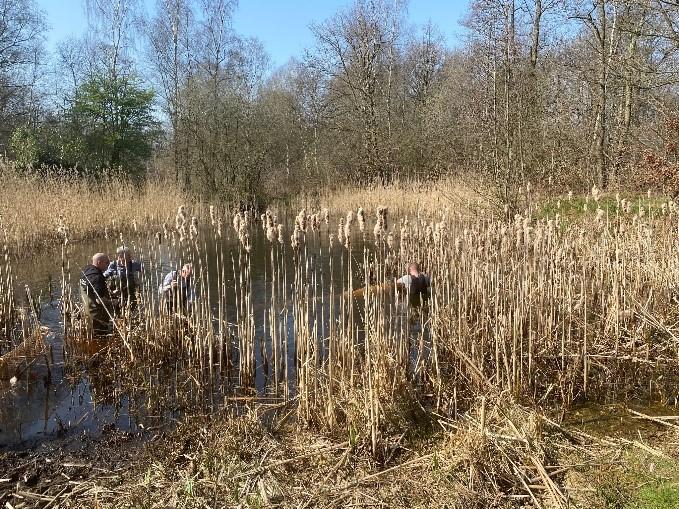
February 18, 2022
The American bullfrog is now also advancing in Limburg. They were discovered thanks to the innovative eDNA-techniques used in the LIFE 3n-bullfrog project.
October 13, 2021
Trapping efforts for 2021 are still ongoing. The final trapping efforts are currently taking place in Heist-Op-Den-Berg, among other places, where the Natuurwerk team has caught a few large specimens in the fykes. Rtv came by for a short report:
July 5, 2021
American bullfrogs, where do they come from and how can you recognize them? What is on their diet and why is the species so harmful to our nature? How are we going to eradicate this threat to our nature? You will find out this and much more in the small exhibition that we have set up and which is now ready for viewing in the Grote Netewoud visitor center. The exhibition can be visited all summer, so be sure to take a look if you have a summer walk planned in the area.
Speaking of summer walks, on August 22 our local division of Natuurpunt is organising a guided walk in the area, with the American bullfrog as its main topic. You can combine a visit to our exhibition with a refreshing walk in the nearby Griesbroek, where you will almost certainly encounter some bullfrogs.
July 4, 2021
The first pond has now been cleared of all fish, drained and cleaned. All we have to do now is wait until everything has settled and we can release the first tadpoles in our enclosures
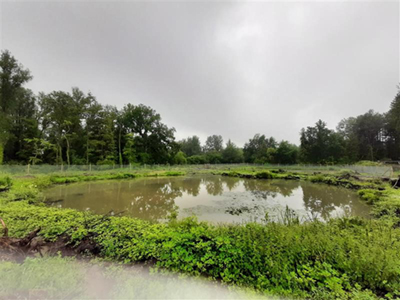
May 21, 2021
All pond are now properly fenced. Next step is to prepare the actual ponds for releasing sterile tadpoles. We will need to catch and relocate all fish that are present in the ponds, drain them and clean them out.
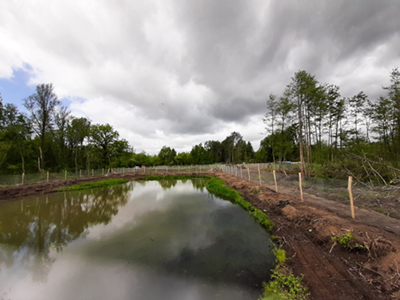
Today also happens to be the Birthday of Nature, which we celebrate with a walk in the Griesbroek nature area.
May 3, 2021
Construction works are going as planned, small dykes have been erected around the ponds to help protect against floods and the first pond is now fulle fenced.
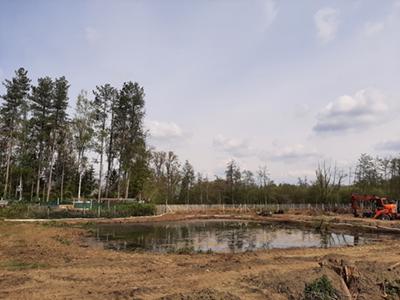
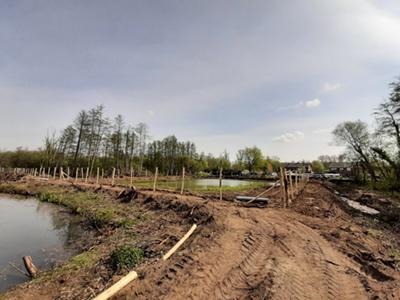
March 25, 2021
The last few sunny days have caused an explosion of amphibian activity in our ponds. Sadly there are also American bullfrogs present and reproducing in these ponds. Before we can use the ponds for raising sterile frogs, the fish and amphibian populations need to be removed and relocated.
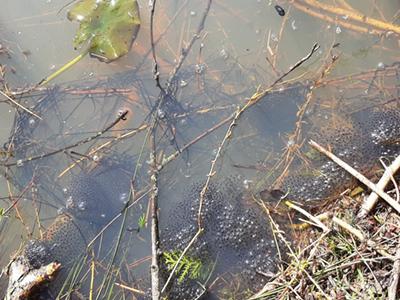
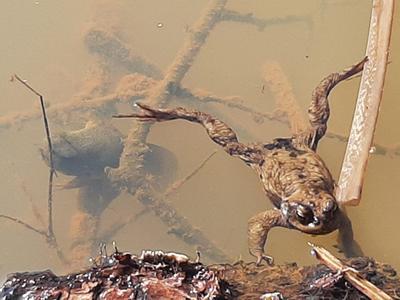
Left: common frog and common toad spawn - Right; an adult common toad and a bullfrog tadpole
March 22, 2021
Construction works have commenced for our first site with four ponds in Olmen, where we will be rearing sterile tadpoles and juvenile frogs. The trees surrounding the ponds have been cleared. Luckily most of these were exotic species with fairly low ecological value.
Now that the trees have been cleared, the terrain will be leveled and fencing will be installed around the ponds. This fence (with 1 cm mesh size) prevents escaping frogs and at the same time also prevents animals from entering the ponds from outside. This way the sterile animals can grow up peacefully and safely.
December 11, 2020
The Life 3n-bullfrog project has started around a year ago. But how do we plan to eradicate bullfrogs from Flanders and why is this important? Find out in this info video.
August 28, 2020
Yesterday the LIFE 3n-bullfrog project was covered by the news. Fykes, frogs and tadpoles were examined with great interest while our project employees gave explanations. Did you miss it? You can view and read the various reports again with the links below:
August 27, 2020
August 14, 2020
We now have a informational folder (pdf - 2.90 MB), which you can download.
May 6, 2020
To be able to catch even the smallest bullfrog tadpoles, we now use fykes with a mesh size of only 5 mm! The leader is also a bit longer to improve catch efficiency.
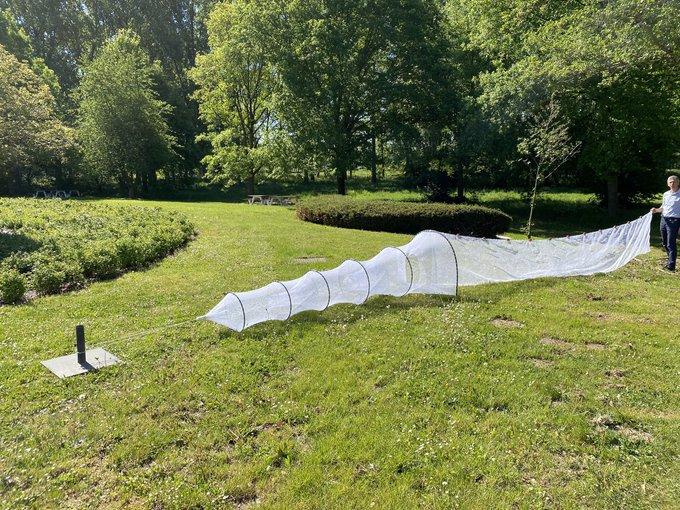
May 4, 2020
The first bullfrogs of the 2020 season have arrived in the PXL Bio-Research lab. The breeding season can now fully start! Excellent work by Natuurwerk vzw!
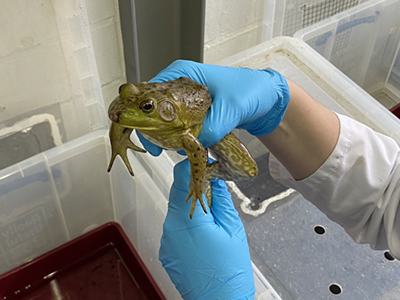
April 25, 2020
Our LIFE project can now also be found on Twitter: https://twitter.com/LifeStierkikker
April 10, 2020
Have you spotted or heard a bullfrog? Let us know!
It is of the utmost importance to act quickly on new sightings of American bullfrogs. And for that we need your help! Have you seen or heard a bullfrog? Enter your sighting on www.waarnemingen.be.
December 2019
The LIFE 3n-bullfrog project officially started in October. Fieldwork preparations have started, and so has the development of a project logo.

Who are we?
LIFE 3n-bullfrog is a collaboration between the PXL University, Research Institute Nature and Forest, The Institute for Nature and Forestry of the Flemish Government and Natuurpunt vzw.
PXL University
The PXL University of Applied Sciences is a young and dynamic organization; a center of expertise for innovation, creativity and entrepreneurship. The university of applied sciences offers professional bachelor's degree programs in a wide range of sectors, as well as offering both bachelor's and master's degree programs in art. PXL research has seven centers of expertise, of which three cells participate in major projects. The Bio-Research department mainly focuses on applied research in biodiversity and public green areas, but also on research of invasive exotics, especially methods for population control. The Bio-Research research group of the PXL University has been working on the American bullfrog for years and is considered one of the most important centers of knowledge on the species. This is where the development of the method to breed triploid sterile bullfrogs originated.
Research Institute Nature and Forest (INBO)
The Research Institute for Nature and Forest (INBO) is the independent research institute of the Flemish government that underpins and evaluates biodiversity policy and management by means of applied scientific research, data and knowledge sharing. INBO wants to be the point of contact in Flanders to provide evidence-based support for nature policy and its implementation. It describes the state and trends of biodiversity and ecosystem services, investigates causes of change and develops directly applicable instruments. It develops future studies that underpin nature policy in the longer term. We always do this in dialogue with partners from society, science, policy and management.
Institute for Nature and Forestry
The agency is responsible for policy, sustainable management and strengthening nature together with all partners. Nature and Forest of the Flemish government cherishes, protects and develops more than 90,000 hectares of nature reserves, forests and parks in Flanders. The Agency for Nature and Forestry strives for more and better nature in Flanders and wants to place nature at the heart of society.
Natuurpunt
Natuurpunt is an independent volunteering association with more than 123,333 members. It protects vulnerable and endangered nature in Flanders. Natuurpunt manages more than 25,000 hectares of Flemish nature in 500 different nature reserves. The volunteers take the initiative: they take care of purchasing, management and opening up of nature reserves. They are assisted by professional teams. With a strong network of hiking trails, viewing huts, benches, play forests and visitor centers, we give everyone the opportunity to enjoy nature.
Would you like to know more about the project, or do you have specific questions, feel free to contact one or more of the associated partner organisations:
PXL University:
- Timon Smeets (Timon.Smeets@pxl.be )
- Alain De Vocht (alain.DeVocht@pxl.be)
- Sarah Descamps (sarah.descamps@pxl.be)
Nature and Forestry:
- An Wouters (an.wouters@vlaanderen.be)
- Nicolas Pardon (nicolas.pardon@vlaanderen.be)
Natuurpunt:
- Peter Engelen (peter.engelen@natuurpunt.be)
INBO:
- Rein Brys (rein.brys@inbo.be)
Province of Antwerp:
- Mieke Hoogewijs (mieke.hoogewijs@provincieantwerpen.be)
And of course you can follow our project on X, Facebook, and Youtube!
